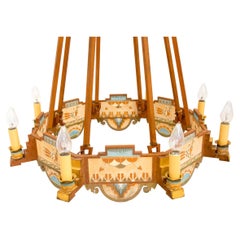Southwest Chandelier
Recent Sales
Early 20th Century American Native American Chandeliers and Pendants
Metal
A Close Look at Native-american Furniture
Native American broadly describes any Indigenous people in North America and encompasses hundreds of tribes and groups, all with distinct cultures. Native American–style furniture and decor likewise varies widely, from pieces created by Indigenous people to those appropriated by non-native designers.
Indigenous furniture’s rich heritage includes the bentwood boxes of the Northwest Coast carved from cedar for storing household or ceremonial objects. Generations of Native American people have made baskets for holding household items, with those in the Northeast using sweetgrass and those in the Southeast using pine needles and wicker. Artisans in the Plateau region wove watertight pieces like cradles from plant materials. Although these objects were intricately made, they were usually utilitarian rather than decorative.
The colonization of North America and the removal of Indigenous people from their lands led to the suppression of these practices. Many styles that used Native American motifs — such as Southwestern style, which was heavily influenced by the geometric patterns of Navajo textiles — have historically not involved Indigenous creators and, instead, have taken their traditions without their tribal context.
When decorating a home with Native American–style furniture, it is important to do so respectfully, by understanding the origins of motifs and objects and examining who profits from their sale. There are now Indigenous-led companies, such as Cherokee designer Cray Bauxmont-Flynn’s Amatoya and Totem House Design, promoting Indigenous work in furniture and home decor. Supporting Indigenous artists and artisans is essential to confronting the still pervasive issue of cultural appropriation in design.
Find a collection of Native American living room furniture, folk art, rugs and carpets, decorative objects and other items on 1stDibs.
Finding the Right Painted-furniture for You
Vintage, new and antique painted furniture enhances a room through patterns, blocks of color and ornamental flourishes. Decorating furniture with paint was especially prominent in the 18th and 19th centuries in the United States when folk artists used chairs, chests, tables and cupboards as their canvases. Although a later trend involved stripping antique pieces of their paint, early American homes were vivid with furniture painted in an array of colors.
The practice of painting furniture has a rich heritage, with remnants of pigment identified on a 12th-century painted chair from Sweden. It has come in and out of fashion over time — in the design of 17th-century Mannerist furniture, paint was lightly used to enhance carved ornamentation, and painted furniture gained popularity with designers working in the chinoiserie style, as 18th-century European artisans mimicked Chinese lacquer in furniture motifs. In France in the 18th century, furniture was lavishly painted or gilded in gold.
Now painted furniture is popular for pieces that are both utilitarian and works of art. A color from a pattern can inform the whole design of a room, or, as bold and saturated tones are in vogue, a vibrantly adorned piece can be a bold focal point. Muted palettes can contribute to an air of calm for a study or bedroom while bright reds, yellows or blues can enliven a dining room or living room.
On 1stDibs, find a variety of vintage, new and antique painted furniture to match any space or taste.
